In today’s fast-paced IT environment, Managed Service Providers (MSPs) are increasingly adopting remote work models. This shift necessitates rethinking workspace dynamics to ensure efficiency, productivity, and employee satisfaction. Let’s dive into how MSPs can create a better environment for their remote staff by focusing on aspects like MSP remote staff management, help desk best practices, and effective communication strategies.
1. Establish a Robust Remote Infrastructure
Two major avenues lead to an improved remote infrastructure:
Essential Tools: Equip your remote MSP staff with the necessary hardware and software that will seamlessly complement the unique world of providing IT support.
Secure Connections: Implement VPNs and other secure remote access solutions to protect sensitive data.
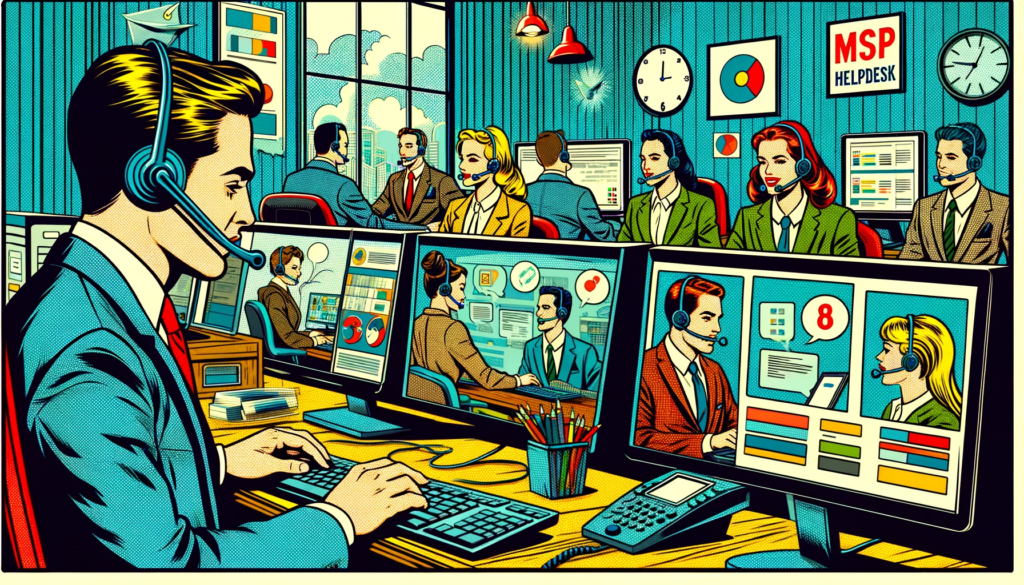
Let’s look into these action steps further.
1.1 Essential Tools for Remote Work
Providing your staff with the necessary hardware is crucial. This includes not just reliable laptops or desktops, but also monitors, ergonomic keyboards, and mice. High-quality hardware reduces the risk of technical issues and improves overall work efficiency.
- Ergonomic Furniture: It’s essential to consider the physical health of your employees. Ergonomic chairs and adjustable desks can prevent strain and injury caused by long hours of sitting. Encourage or subsidize the purchase of such furniture to promote a healthier workspace.
- Internet Connectivity: Since remote work heavily relies on internet connectivity, it’s vital to ensure that your staff has access to high-speed internet. This might involve subsidizing their internet plans or providing guidance on choosing the best service providers in their area.
- Noise-Cancellation Headphones: In a remote setting, distractions can be a significant hindrance. Providing noise-canceling headphones helps staff concentrate better, especially those in noisy environments.
1.2 Secure Connections for Data Protection
Below are some of the best ways to combat cyber attacks and data breaches.
- Virtual Private Networks (VPNs): Implementing VPNs is crucial for secure remote work. They encrypt internet traffic, ensuring that sensitive data remains confidential and secure from cyber threats.
- Multi-Factor Authentication (MFA): Alongside VPNs, enforce MFA for accessing company resources. This adds an extra layer of security, significantly reducing the chances of unauthorized access.
- Regular Security Updates and Training: Ensure that all remote devices are regularly updated with the latest security patches. Additionally, conduct regular training sessions on cybersecurity best practices to keep your team informed and vigilant.
- Secure Remote Access Solutions: Besides VPNs, consider other remote access solutions. Premium MSPs love to use virtual desktop infrastructure (VDI) or cloud services–with a popular one being Microsoft Azure. These solutions offer secure and efficient ways for staff to access necessary applications and data remotely.
- Data Backup and Recovery Plans: Implement robust data backup and recovery plans. Regular backups and a clear recovery strategy are essential to prevent data loss and ensure business continuity in case of any data breaches or technical failures.
By implementing these actions, MSPs can create a robust and secure remote security plan.
2. Communication between IT Help Desk Staff
One of the biggest challenges for MSPs with remote operations is coordinating online communication among team members who are all living in different locations and time zones. We will look at the following two areas that help to ameliorate these challenges.
Regular Check-ins: Implement daily or weekly video calls to foster team cohesion.
Effective Tools: Utilize communication platforms like Slack or Microsoft Teams for instant messaging and collaboration.
2.1 Regular Check-ins for Team Cohesion
- Daily Stand-ups: Implementing a brief daily stand-up meeting can be highly effective. In these meetings, each team member quickly updates the team on what they did the previous day, what they plan to do today, and any blockers they’re facing. This helps keep everyone aligned and informed.
- Weekly Video Calls: These allow for more in-depth discussions and team bonding. These sessions can be used for project updates, brainstorming sessions, and addressing any complex issues that require team input.
- Regular One-on-One Meetings: Encourage managers or team leads to have regular one-on-one video calls with their team members. These meetings can provide a platform for personal feedback, career development discussions, and addressing any individual concerns or challenges.
- Virtual Team-Building Activities: Periodically organize virtual team-building activities during these calls, like quizzes or informal chats, to foster a sense of community and teamwork.
2.2 Effective Tools for Communication and Collaboration
- Instant Messaging Platforms: Tools like Slack or Microsoft Teams are essential for day-to-day communication. They allow for instant messaging, file sharing, and creating specific channels for different projects or topics, ensuring organized and focused discussions.
- Collaboration Tools Integration: Many of these platforms integrate with other tools (like Asana, Trello, or Jira) used for task management, which can streamline workflows and keep all communications centralized.
- Video Conferencing Tools: Besides regular text-based communication, having reliable video conferencing tools is vital. This includes software like Zoom, Microsoft Teams, or Google Meet for real-time video interactions.
- Document Sharing and Collaboration: Utilize cloud-based document-sharing platforms like Google Drive or SharePoint. These tools allow multiple team members to work on the same document simultaneously, enhancing collaboration and efficiency.
- Feedback and Recognition Platforms: Implement platforms where team members can give and receive feedback or recognize each other’s contributions. Tools like Bonusly or 15Five can help maintain a positive work culture and morale.
By prioritizing these communication strategies and tools, IT help desk staff in remote settings can enjoy a more cohesive, collaborative, and efficient work environment. Regular communication fosters a team culture where members feel connected and valued, despite the physical distances. Effective use of technology tools enhances productivity and ensures that the team stays on the same page with their tasks and goals.
3. Optimizing Help Desk Best Practices
If your MSP’s concept of a help desk is technicians cherry-picking support issues that come in, with no monitoring of the completion of tasks and when they are assigned, your help desk is probably pretty chaotic. But there are two areas that can swiftly get it under control, which are the following:
Ticketing System Efficiency: Invest in a robust ticketing system for your remote help desk. This system should enable easy tracking, prioritization, and resolution of IT issues.
Knowledge Base Development: Create a comprehensive knowledge base. This resource can significantly reduce resolution times and empower staff to solve common issues independently.
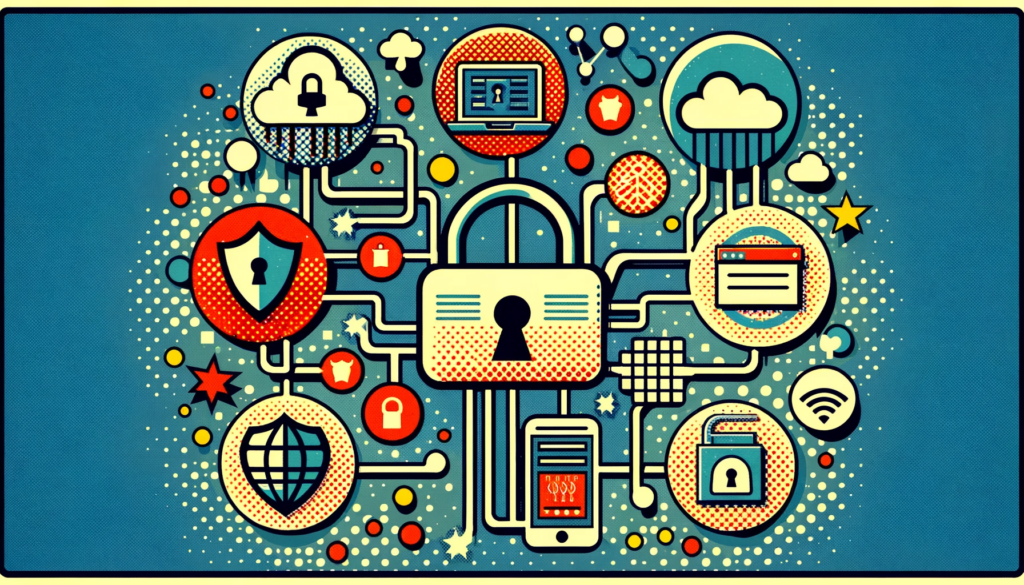
It’s crucial to get your ticket-handling process flowing smoothly, so let’s start with that.
3.1 Ticketing System Efficiency
- Choosing the Right Ticketing System: Select a ticketing system that aligns with the scale and needs of your MSP. Look for features like user-friendly interfaces, scalability, automation capabilities, and integration with other tools (like CRM systems and communication platforms). Connectwise is popular for MSPs, as are a few others!
- Automation and Workflow Optimization: Implement automation within the ticketing system to handle routine tasks like ticket assignment, status updates, and escalation procedures. This not only speeds up the process but also reduces human error.
- Prioritization and Categorization: The system should allow for effective prioritization and categorization of tickets based on urgency and complexity. This helps in allocating resources efficiently and ensures that critical issues are addressed promptly.
- Performance Tracking and Analytics: Use the ticketing system’s analytics features to track KPIs like resolution times, customer satisfaction scores, and ticket volumes. This data can be used for continuous improvement of help desk operations.
- Training Staff on the System: Ensure that all staff members are thoroughly trained on using the ticketing system. This includes understanding its features, best practices for logging and updating tickets, and leveraging the system for effective communication with clients.
3.2 Knowledge Base Development
- Creating a Comprehensive Repository: Develop a knowledge base that includes detailed documentation on common issues, troubleshooting steps, FAQs, and standard procedures. This should be a living document that is regularly updated with new findings and solutions.
- Accessible and User-Friendly Design: The knowledge base should be easily navigable and searchable. Use clear headings, categorization, and a search function to help staff find the information they need quickly.
- Incorporating Feedback Mechanisms: Implement a system where staff can provide feedback on the knowledge base content – such as suggesting updates, pointing out inaccuracies, or highlighting missing information.
- Integrating with the Ticketing System: If possible, integrate the knowledge base with your ticketing system. This allows staff to easily reference and link to relevant articles when resolving tickets.
- Promoting a Culture of Knowledge Sharing: Encourage a culture where staff members contribute to the knowledge base by documenting new solutions and insights. This not only enriches the resource but also fosters a collaborative work environment.
By enhancing the efficiency of ticketing systems and developing a robust knowledge base, MSPs can significantly improve the effectiveness and productivity of their remote help desk operations. These best practices not only streamline the resolution process but also empower the staff to deliver high-quality, timely support to clients.
4. Training and Development
Let’s talk about making sure your staff is trained and up-to-speed on your expectations of them. The two major components that keep this area of your MSP thriving are the following:
Continuous Learning: Offer regular training sessions and access to online courses. This approach ensures that your staff is up-to-date with the latest IT trends and technologies.
Soft Skills Enhancement: Don’t overlook the importance of soft skills. Training in areas like customer service and communication is crucial for remote service desk success.
Let’s expand on these aspects of training and development further.
4.1 Continuous Learning
- Structured Training Programs: Develop structured training programs that cover various IT domains relevant to your services. This could include network management, cybersecurity, cloud technologies, and specific software tools. Regularly updating these programs ensures that your team is knowledgeable about the latest developments in these areas.
- Access to Online Courses and Certifications: Provide access to online learning platforms like Coursera, Udemy, or LinkedIn Learning. Encourage staff to pursue certifications that are relevant to their roles and the MSP’s service offerings. This not only enhances their skill set but also adds value to your team’s expertise.
- Scheduled Learning Time: Allocate specific hours or days for learning within the work schedule. This shows that the organization values and supports the professional growth of its employees.
- Peer Learning and Mentorship Programs: Facilitate peer-to-peer learning sessions or mentorship programs where more experienced staff can share their knowledge and skills with newer team members. This can be an effective way to foster a culture of learning and collaboration within the team.
- Learning Pathways for Career Progression: Create clear learning pathways that align with career progression within the organization. This helps staff understand how their learning and development fit into their career goals and the company’s objectives.
4.2 Soft Skills Enhancement
- Customer Service Training: Since MSP staff often interact with clients, training in customer service is essential. This includes handling difficult conversations, empathy, active listening, and effective problem-solving.
- Communication Skills: Effective communication, especially in a remote environment, is crucial. Training should cover aspects like writing clear emails, conducting productive virtual meetings, and using collaborative tools effectively.
- Teamwork and Collaboration: Foster skills in teamwork and collaboration. This is particularly important in a remote setting where team members are not physically together. Training can cover best practices for remote collaboration, building trust in virtual teams, and managing remote projects.
- Time Management and Organization: Offer training on time management and organization skills. Remote work requires a high degree of self-management, and skills in these areas can significantly enhance productivity and reduce stress.
- Emotional Intelligence: Training in emotional intelligence can be beneficial, particularly in understanding and managing one’s emotions and empathizing with others. This is key in building strong working relationships and handling client interactions effectively.
By focusing on both continuous learning and soft skills enhancement, MSPs can ensure that their staff is not only technically proficient but also adept in the interpersonal aspects required for a successful remote service desk. This comprehensive approach to training and development is crucial for the overall success and growth of both the employees and the organization.
5. Encouraging a Healthy Work-Life Balance
When your MSP staff doesn’t report to a physical office every week, they can develop unhealthy boundaries between work and home life. It’s important to empathize with your staff in order to be a great remote boss.
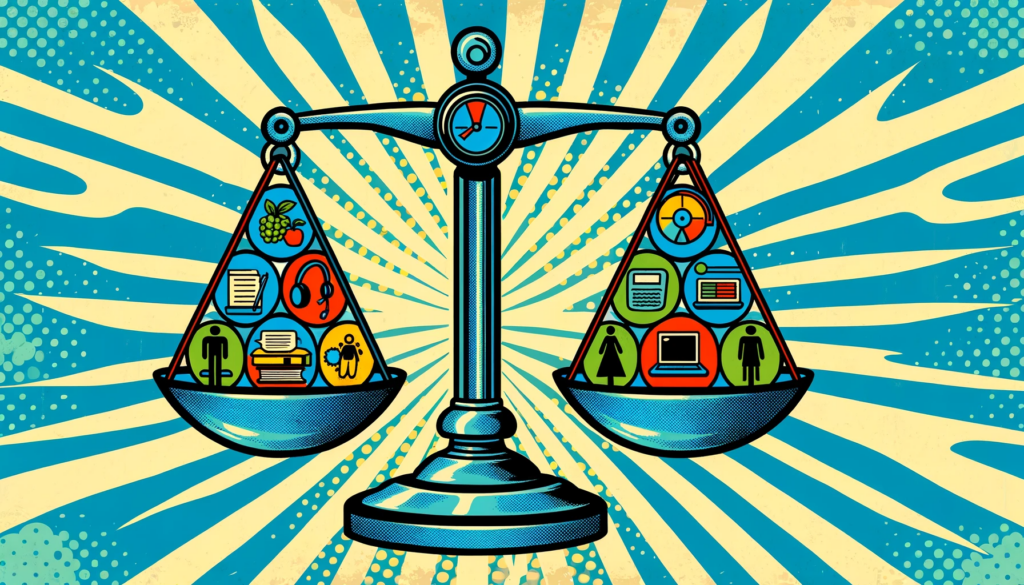
Working remotely on an MSP help desk can be more tedious and taxing compared to other remote jobs. However, if handled correctly, remote working can benefit your MSP helpdesk immensly. Here’s how to make the most of the positives and mend the negatives:
| Positives of Remote Work | Negative Repercussion |
| Team members working in various time zones allows for support coverage for a global clientele | Team members working in various time zones also creates communication gaps that prevent everyone from being on the same page and being up-to-speed on company policies, strategies and implementations |
| Those working from home can find a remote job working from anywhere from the comfort of their home | Employees working from home can feel isolated and disconnected from their peers |
| Employees working remotely can work outside of your regular business hours, allowing your MSP to offer more support hours | Some employees might reluctantly accept positions where they have to work later or earlier, and secretly grow to resent their job |
| It’s cost-effective to not maintain an office and hire global talent | Having scattered employees can lead to a hectic virtual office environment where employees feel overwhelmed and destabilized |
| Employees can do their best work when they don’t feel the pressure of someone looking over their shoulder throughout the day | Employees may not feel secure in their role due to a lack of communication and touching base. They may develop frustration or paranoia due to feeling out of the loop |
Here are two impactful ways to combat those issues we’ve laid out:
Flexible Schedules: Implement flexible working hours to accommodate different time zones and personal commitments.
Well-being Programs: Introduce initiatives like virtual yoga classes or mental health days to support staff well-being.
Here’s a deeper look at how MSPs can promote this balance through flexible schedules and well-being programs.
5.1 Implementing Flexible Schedules
- Customizable Work Hours: Allow staff to customize their work hours within a given framework. This could mean letting them start and end their day earlier or later, as long as they’re available during core business hours for meetings and collaboration.
- Time Zone Sensitivity: For MSPs with a global team, being sensitive to different time zones is crucial. Avoid scheduling meetings at inconvenient times for team members in vastly different time zones and try to rotate meeting times to share the inconvenience equitably.
- Results-Oriented Work Environment (ROWE): Emphasize a results-oriented approach where the focus is on the quality and completion of work rather than the number of hours logged. This encourages efficiency and allows employees to manage their time according to their productivity peaks.
- Encourage Regular Breaks: Encourage employees to take regular short breaks throughout the day to rest, especially for those in high-strain roles like IT support. This can prevent burnout and maintain high levels of concentration.
5.2 Introducing Well-Being Programs
- Virtual Wellness and Fitness Classes: Organize virtual wellness activities like yoga, meditation, or fitness classes. These sessions can be conducted by professional instructors and can help in reducing stress and improving physical health.
- Mental Health Support: Provide access to mental health resources such as counseling services or stress management workshops. Creating an environment where mental health is openly discussed and supported can be beneficial for overall employee well-being.
- Regular Check-Ins on Well-being: Implement regular check-ins by managers or HR to discuss not just work-related issues but also to gauge the well-being of staff members. This can help in identifying any issues early and providing support where needed.
- Encouraging Time Off: Actively encourage employees to take their allotted vacation time. Ensure that taking time off is not stigmatized but is seen as an essential part of maintaining a healthy work-life balance.
- Social Interaction and Community Building: Create opportunities for social interaction, such as virtual coffee breaks or non-work-related online meetups. This can help build a sense of community and combat the isolation that can sometimes accompany remote work.
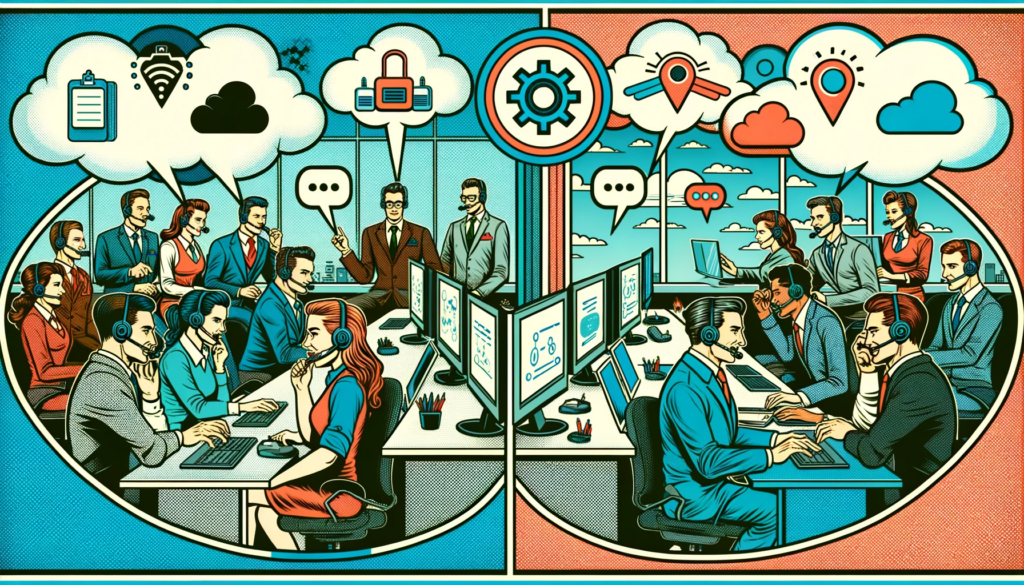
By implementing these strategies, MSPs can significantly contribute to their employees’ ability to maintain a healthy work-life balance. This not only enhances employee satisfaction and well-being but can also lead to increased productivity and a more positive work environment.
6. Building a Hybrid Helpdesk
It’s time to create a blend of the remote and on-site workplace: For some MSPs, a hybrid model combining remote and on-site work can be effective. This approach allows for in-person collaboration when necessary while retaining the flexibility of remote work.
6.1 Crafting the Hybrid Model
- Defining the Hybrid Structure: Determine how the hybrid model will function in your organization. This could involve staff working part-time in the office and part-time remotely, or having certain roles that are entirely remote while others require some office presence.
- Flexible Scheduling: Allow employees to choose the days they prefer to work on-site, within company policy limits. This flexibility can improve employee satisfaction and productivity.
- Role-Based Approach: Consider the nature of different roles when implementing a hybrid model. Some positions might require more in-office presence (like hardware support roles), while others can be performed effectively in a fully remote setting (like software development or administrative tasks).
6.2 Optimizing In-Person Collaboration
- Effective Use of Office Time: When staff are on-site, focus on activities that benefit most from in-person interaction, such as team meetings, brainstorming sessions, or complex project planning.
- Creating Collaborative Spaces: Design office spaces that encourage collaboration and interaction, such as open meeting areas, lounges, and brainstorming rooms.
6.3 Ensuring Consistency Across Work Environments
- Unified Communication Tools: Use the same communication and collaboration tools for both remote and on-site staff to ensure consistency and ease of access to information.
- Regular All-Hands Meetings: Host regular all-hands meetings, either virtually or in a format that allows both remote and on-site employees to participate equally. This helps in maintaining a unified company culture.
6.4 Addressing the Challenges of a Hybrid Model
- Managing Remote and On-site Teams: Develop strategies to manage both remote and on-site teams effectively. This includes regular check-ins, ensuring equitable access to resources, and fair distribution of opportunities.
- Training for Hybrid Work: Provide training for managers and staff on best practices for hybrid work, focusing on communication, time management, and leveraging technology effectively.
6.5 Leveraging Technology to Bridge the Gap
- Invest in Collaboration Technology: Utilize technology that bridges the gap between remote and on-site work. This can include advanced video conferencing systems, project management tools, and cloud-based platforms.
- Virtual Participation in Meetings: Ensure that meetings are set up in a way that remote participants can join and engage effectively, with good-quality audio and video.
By carefully implementing and managing a hybrid helpdesk, MSPs can create a flexible and dynamic work environment that caters to the needs of their diverse workforce. This approach can lead to increased employee satisfaction, better collaboration, and a more inclusive workplace culture.
7. Leveraging Cloud Technologies
This strategy involves utilizing cloud-based solutions to enhance the efficiency and flexibility of MSP operations. Cloud technologies offer numerous benefits, especially for remote and hybrid work environments. Let’s delve into the specifics:
7.1 Adoption of Cloud-Based Tools
- Selection of Cloud Services: Choose cloud services that best fit your organization’s needs. This could include cloud storage platforms (like Google Drive or Dropbox), cloud-based project management tools (like Asana or Trello), and cloud-based customer relationship management (CRM) systems (like Salesforce).
- Integration of Cloud Tools: Ensure that the selected cloud tools can integrate seamlessly with each other. This integration can streamline workflows, allowing for more efficient data transfer and communication between different platforms.
7.2 Enhancing Collaboration through Cloud Technologies
- Real-Time Collaboration: Utilize cloud platforms that allow multiple users to work on documents or projects simultaneously in real time. This capability is crucial for teams that are distributed across different locations.
- Accessible Communication Platforms: Implement cloud-based communication tools (like Slack, Microsoft Teams, or Zoom) that facilitate easy and effective communication among team members, regardless of their physical location.
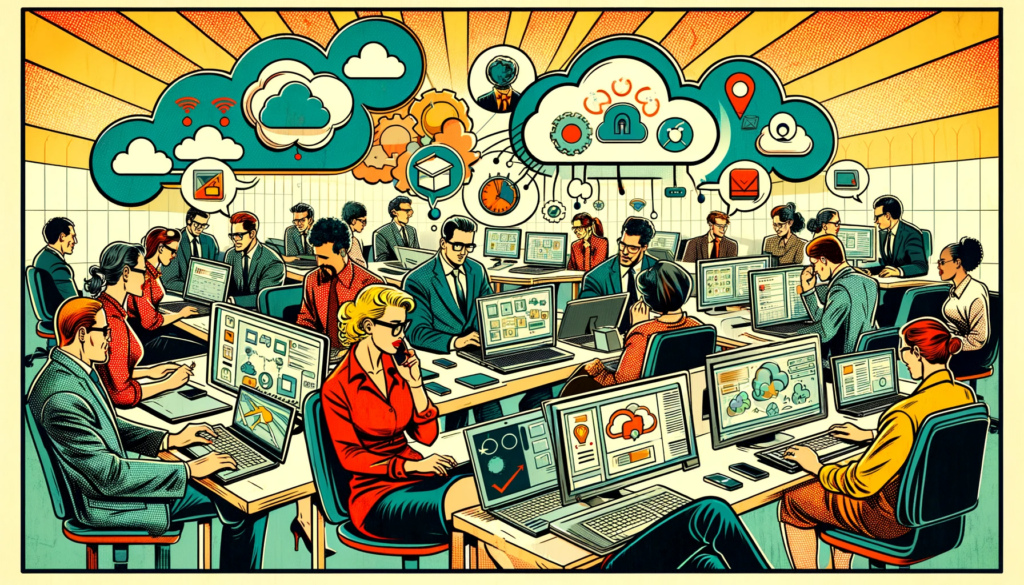
7.3 Cloud Storage and Data Management
- Centralized Data Storage: Use cloud storage solutions to keep all data centralized and accessible to all team members. This approach not only enhances collaboration but also helps in maintaining data consistency and integrity.
- Data Backup and Recovery: Leverage cloud technologies for secure data backup and recovery processes. Cloud storage can offer more robust and reliable backup solutions compared to traditional methods, ensuring business continuity in case of data loss.
7.4 Scalability and Flexibility
- Scalable Solutions: Choose cloud services that offer scalability. This allows your MSP to easily scale resources up or down based on demand, without the need for significant infrastructure investments.
- Adapting to Business Needs: Cloud solutions provide the flexibility to quickly adapt to changing business needs, such as introducing new tools, expanding storage capacity, or adjusting to growing team sizes.
7.5 Security and Compliance in the Cloud
- Ensuring Data Security: Implement robust security measures for your cloud platforms, including encryption, secure access controls, and regular security audits.
- Compliance with Regulations: Ensure that your cloud solutions comply with relevant data protection and privacy regulations. This is especially important for MSPs handling sensitive customer data.
By leveraging cloud technologies, MSPs can significantly enhance their operational efficiency, collaboration, and flexibility. Cloud-based solutions provide a robust framework for supporting a distributed workforce while ensuring data security and compliance. This strategic use of cloud technologies is a key component in modernizing MSP operations and staying competitive in a rapidly evolving IT landscape.
Conclusion
Creating a better workspace for remote MSP staff involves a multifaceted approach, encompassing technical infrastructure, communication, training, and well-being. By prioritizing these areas, MSPs can foster a productive, engaged, and satisfied remote workforce.
If you are in the beginning phases of taking your MSP remote, we’re here to help!
As MSP staffing services specialists, we at Support Adventure have worked with over 70 MSPs over the last 7 years, helping them create culturally compatible and reliable remote help desks with dedicated technicians. These techs adhere to your SOPs, ticketing system, training plan, stack, and much more. So click here if that is music to your ears and you are interested in working with us.



0 Comments